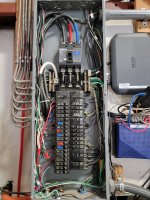Master_Krafter
Member
- Location
- Seattle, WA
- Occupation
- Electrical contractor
Service call for frequent shutdown of computers and lighting flickers.
3 phase service to an office warehouse. Mostly 129v circuits aside from basic hot water(30a 208v) and ac(17a 208v). Showing some wild readings.
LN 1 - G 134v
LN 2 - G 115v
LN 3 - G 111v
this is with basic operation.
Add a microwave on LN 3 and the voltage jumps
LN 1 - G 140v
LN 2 - G 118v
LN 3 - G 101 - 108v
utility provider is reporting 90a spikes but no significant voltage changes. Grounding and bonding is solid. Anyone have some knowledge to share?
3 phase service to an office warehouse. Mostly 129v circuits aside from basic hot water(30a 208v) and ac(17a 208v). Showing some wild readings.
LN 1 - G 134v
LN 2 - G 115v
LN 3 - G 111v
this is with basic operation.
Add a microwave on LN 3 and the voltage jumps
LN 1 - G 140v
LN 2 - G 118v
LN 3 - G 101 - 108v
utility provider is reporting 90a spikes but no significant voltage changes. Grounding and bonding is solid. Anyone have some knowledge to share?



